Do you know that the global food distribution market is valued at USD 221.65 billion in 2022 and is expected to grow in CAGR of 10.3% in 2023 to 2030. (Grandview Research)
In many players in the market, UberEats stands out as an industry benchmark. With its spontaneous user experience, advanced AI-operated logistics, and many revenue currents, UberEats set the standard of gold for the food distribution app.
Therefore, if you are an entrepreneur, the owner of the restaurant, or investors who are creating apps like UberEats from scratches, then you are in the right place. This guide will break all the things on how to make an apps like UberEats – from market trends in food delivery apps and commercial models to development stages and cost estimates. Let’s dive!
How The Market for On-Demand Food Delivery App Like UberEats Is Rising?
Rise of on-demand food delivery app solution has become an essential service, developing beyond the convenience for a competitive, technical-powered industry. The change towards cloud kitchen, AI in food delivery app and autonomous delivery is how food reaches customers. Membership models such as Uber increase customer loyalty, while blockchain-based payments ensure secure transactions. With innovation at its core, the food distribution landscape continues to develop, rapid, provides clever and more personal experience.
What Are Different Types of Food Delivery Business Models?
Before picking a food delivery app development company and starting your mobile app development, you need to define the right business model for food delivery app like UberEats, There are three main types:
Aggregator Model (Third-Party Marketplace)
This is a traditional food delivery system where the app acts as a bridge between the users and the restaurants and functions as the third party. A consumer can browse several hotels, restaurants offering different cuisines and the app allows consumers to order through the app. The consumer can check out the menu, reviews and other crucial details before selecting the restaurant. Once the consumer places an order, the order is confirmed by the restaurant and the food is packed and sent for the delivery. The app does not play any role here, except being a medium between the consumer and the restaurant.
Pros: Less operational costs, easier to scale
Cons: No control over delivery speed & customer experience
Platform to Consumer Model (UberEats, DoorDash, etc.)
Platform to Consumer ModelSo, the platform-to-consumer model forms the backbone of apps such as UberEats or DoorDash whereby the platform takes care of both restaurant listings and delivery logistics. This gives the platform the leverage for better quality control over service as they can now optimize delivery routes, pricing, and customer experiences. A very big revenue model, however, it requires a stable logistics system being managed and scalable technology. The platform manages the entire process, from taking orders to bringing restaurants onboard and working out delivery logistics.
Pros: Much higher revenue potential; full control over deliveries
Cons: High operational costs, requires strong logistics management
Cloud Kitchen Model (Virtual Restaurants)
The cloud kitchen model requires no dine-in space and, therefore, is fully dedicated to online ordering and delivery. It reduces operating costs such that profit margins increase and brands can grow. Rebel Foods or companies like Cloud Kitchens will capitalize on this business model for efficiency, integrating data and insights to refine food menus and optimize delivery operation parameters.
Pros: Low fixed costs; higher profit margins.
Cons: Stronger branding and digital marketing necessary.
What are the must have features for the on-demand food delivery App Like UberEats?
The best food delivery app should offer a seamless, user-friendly experience and effective management for restaurants and smooth operations for delivery partners. The following are the main features to make an app like UberEats that should be incorporated in each section to create a high-performance food delivery platform.
I) For Users:
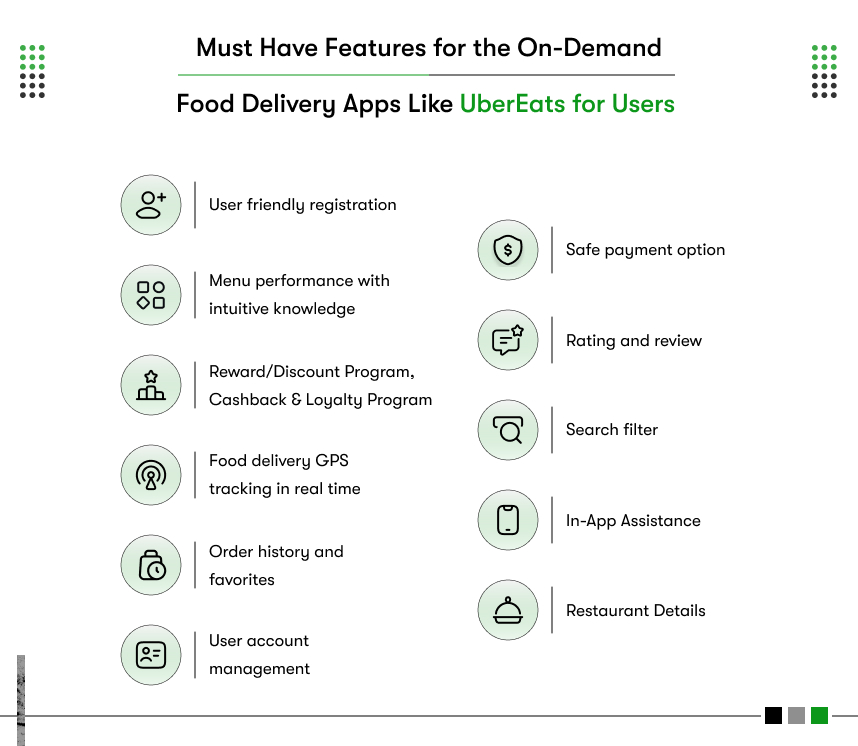
User friendly registration
The registration process should be quick and free from trouble, so that users can sign up using their email, phone number or social media account such as Google or Facebook. A seamless one-tap login with biometric authentication (face ID or fingerprint) can increase security and convenience. Ensuring a smooth onboarding experience helps users to maintain from the beginning.
Menu performance with intuitive knowledge
A clear, organized and visually attractive menu makes browsing easy and attractive. High quality food drawings, detailed descriptions, prices, and adaptation options should be displayed neatly. A well-structured menu layout with classes such as Best-Sellers, Combo Offers and Dietary Preferences helps users to make quick decisions.
Search filter
Users should be able to refine their search results by filtering cuisine, price range, rating, distribution time and dietary preferences (vegetarian, gluten -free, keto, etc.). Depending on distance or availability, improve experiences such as advanced filters. AI-operated smart discovery may also recommend popular cuisine based on previous orders and preferences.
Food delivery GPS tracking in real time
Customers love transparency to order tracking. A real -time tracking system allows users to monitor the status of their order from preparation to delivery. A live map interface must show an estimated delivery time, delivery partner details and their real -time location to increase the user’s confidence and reduce anxiety.

Safe payment option
Several payment gateways ensure that users can easily and safely pay. The app should support Credit/Debit Card, Digital Wallet (Google Pay, Apple Pay, PayPal), UPI, Net Banking and Cash on delivery (COD). The integration of token payments and two-factor authentication (2FA) increases security.
User account management
In user profile sections, customers can easily manage their personal information, such as editing a saved address, changing passwords, and setting delivery options. Users should also have the ability to control and change notification settings and link payment information into their accounts under secure methods.
Order history and favorites
This tab presents the order history that allows the user to keep in view their favorite foods and to keep track of previous expenses. In the” favorite” touch users save ordered items, or favorite restaurants, for quickly accessing whenever an order is needed, making it more efficient and easier.
Rating and review
User-related ratings and reviews help to maintain restaurants and delivery service transparency. Customers should be able to rate food quality, distribution speed and service experience. Allow them to add images and reactions make the review system more reliable and attractive.
Reward/Discount Program, Cashback & Loyalty Program
Offering discount coupons, cashback offers and loyalty rewards increases customer retention. Referral programs where users earn credit to invite friends encourage biological app growth. User increases a dynamic reward system engagement to the user spending habits.
In-App Assistance
There should be an exhaustive help and support section detailing FAQs, live chat with customer support, and the use of AI chatbots, among others, for case resolution. Complaints concerning order, delay in delivery or failure of payment should be raised and answered in real time by the users.
Restaurant Details
Each restaurant should have a profile showing the hours of operation, estimated delivery time, average customer ratings, what type of cuisine is offered, and the price range, as well as the location of the restaurant compared to the customer. A short description about the specialty or history of the restaurant adds credibility and helps customers to make better and informed decisions.
II) For restaurant:
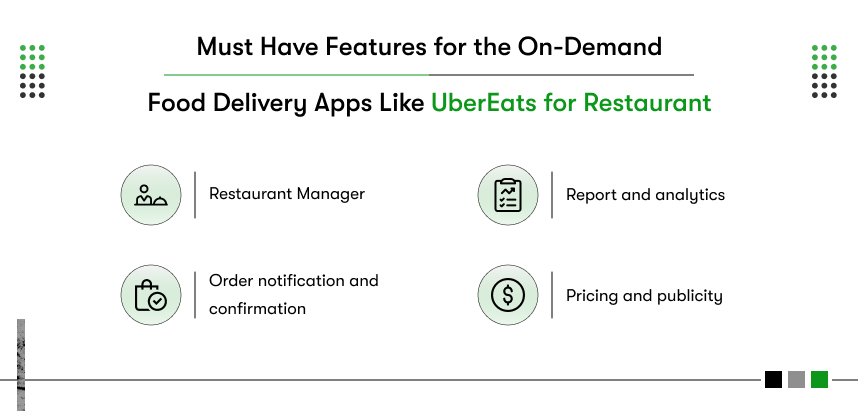
The restaurant requires an efficient dashboard to manage orders, track revenue and optimize operations. These features help them to streamline order processing and improve the quality of service.
Restaurant Manager (All-in-One Dashboard)
An intuitive restaurant allows dashboard owners to manage order, update the menu items, track revenue and control availability in real time. The dashboard should provide trends to help customizing sales insights, peak order time, and restaurants to customize their menu and pricing strategies.
Order notification and confirmation
Instant push notifications, SMS, or email alerts should inform the restaurant owners about new orders, cancellations and customer requests. A spontaneous order confirmation system helps the restaurant prepare food on time and reduce the delay. An integrated communication facility may allow restaurants to coordinate with delivery drivers if needed.
Report and analytics
A wide analytics dashboard provides insight into daily sales, customer preferences, order trends and operational efficiency. Restaurant can track which dishes are the most popular, peak business hours and customer demographics to adjust their marketing and menu accordingly.
Pricing and publicity
The restaurant must have the ability to adjust prices dynamically depending on demand and peak hours. They should also be able to offer special food combo to offer exemption, campaigning and attract more orders. A built -in marketing device that allows restaurants to be paid for a specially displayed listing can also generate additional revenue.
III) For Delivery Partners:
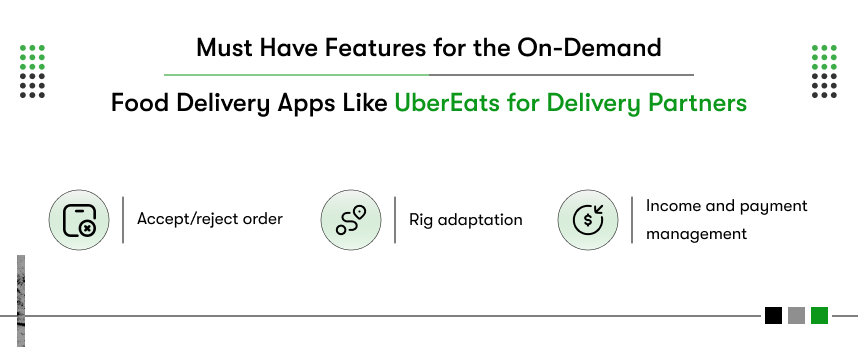
Accept/reject order
Delivery partners must have flexibility to accept or reject distribution requests based on distance, availability and real -time demand. A punishment-free rejection limit should be set to prevent disability by ensuring fairness. If an order is rejected, the system should automatically re -hand it over to another nearby driver.
Rig adaptation
The integrated AI in food delivery app offers route optimization ensures rapid and more efficient delivery. The application should suggest the least, minimal congested routes using real -time GPS navigation. Voice-assured navigation can help drivers to avoid this step carefully.
Income and payment management
A transparent earnings allow the dashboard delivery agents to track full delivery, calculate the bonus and monitor the payout schedule. Drivers should also be able to see their ratings and reactions, which can help them, improve the quality of service. A return feature with daily, weekly, or immediate payment options enhances the satisfaction of the driver.
How to choose Tech Stack to Make App like UberEats?
Choosing the right tech stack assures with the extent to which your food delivery application is affordable, fast, and secure.
- Frontend: Flutter – for a single codebase across iOS and Android with native performance; React Native-Xamarin vs. Swift/Kotlin for a fine experience in the future-native-like interface.
- Backend: Node.js-realty performance; Laravel-really a secure PHP framework; Django-an AI-powered analytics backend
- Database: PostgreSQL for structured data; MongoDB-scalable NoSQL; Firebase – for real-time sync.
- Cloud & Hosting: AWS, Google Cloud, or Azure-reliably performance.
- APIs & Integrations: Google Maps (tracking); Stripe/PayPal (payments); Twilio (notifications).
- Security & DevOps: OAuth 2.0; JWT Encryption; docker; CI/CD set pipelines for secure automated deployment.
How to build app like UberEats? What is Step-by-Step Process?
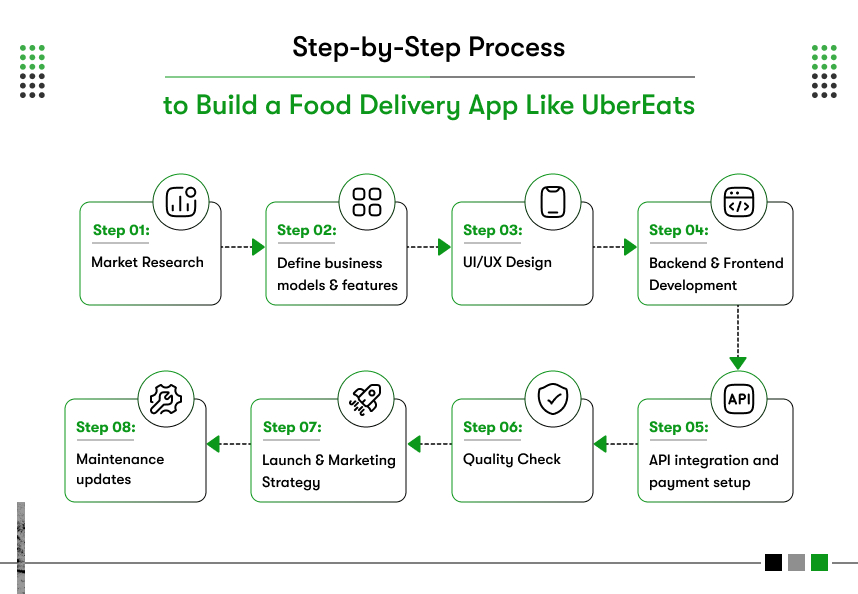
The complete food delivery app solution development procedures need to be structured from planning and design to development and deployment. There is a considerable breakdown of the major stages concerned here:
Step 1: Market Research
To begin app development for food delivery app like UberEats, the obvious need to understand market needs, industry trends, and competitive strategies is required. Research those:
- Target Viewers: Recognize your ideal customers (working professionals, students, families, etc.).
- Competitive Analysis: Study apps like UberEats, Doordash and Zomato to find intervals and unique sales points (USP).
- Business Model Selection: Decide between an aggregator model, platform-to-converse model, or cloud kitchen model based on your budget and goals.
- Metrication Strategy: Define revenue currents, such as distribution fees, commission, restaurant advertising and premium membership.
Step 2: Define business models and features
Once the insight to the market becomes clear, underline the main functionality of your app. You need to define:
- User app features: registration, menu browsing, real -time tracking, safe payment, order history, award and support.
- Restaurant dashboard: Manage orders, update menu, control prices, analyze, analyze and promote.
- Delivery Partner app facilities: order acceptance, route adaptation, tracking income and navigation.
- Administrator Panel Features: User Management, Restaurant Onboarding, Analytics and Serge Pricing.
Step 3: UI/UX Design
Once again, a beautiful and user -friendly interface is important to keep customers. The design process to make an app like UberEats is about:
- Wire framing: Sketch an original blueprint of the screen of the app to imagine the user trip.
- UI/UX Design: Develop an intuitive interface that ensures smooth navigation, easy order placements and quick checkouts.
- Responsible designs: optimize layouts for various screen sizes (mobile, tablet, web).
- Prototype tests: Conduct the purposeful test to gather initial response and refine the design.
Step 4: Backend and Frontend Development
The development focuses on the main functionality of the app:
Frontend Development (User Interface):
- Use react native or pulses for cross-platform compatibility.
- Choose the option of Swift (iOS) or Kotlin (Android) for indigenous performance.
Backend (Server and Database):
- Use node.JS, Laravel, or Django for efficient order processing and API handling.
- PostgreSQL, store user and restaurant data safely with PostgreSQL, MongoDB, or Firebase.
Cloud and hosting:
- Deploy on AWS, Google Cloud, or Azure for scalability and high availability.
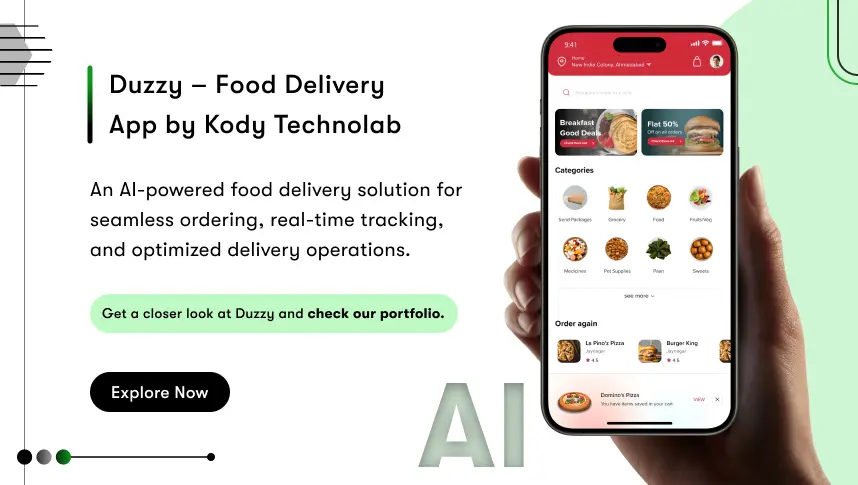
Step 5: API integration and payment setup
To enable the required app functional, integrate the third-party API:
- Google Maps API: The delivery enables real -time GPS tracking and route optimization for partners.
- Payment Gateway (Stripe, PayPal, Razorpay): Ensure safe and uninterrupted transactions with several payment options.
- Twilio/Sich (SMS and Information): Send real -time orders alert, OTP and publicity proposals.
- Firebase push notifications: Keep users associated with order updates and individual deals.
Step 6: Quality Check
This testing ensures that your app run smoothly in various devices and network conditions.
It is divided in below stages
- Unit test: Ensure that each feature works correctly.
- Performance test: speed of test app, load capacity and response time.
- Safety: Verify data encryption and payment security.
- User Acceptance Test (UAT): Conduct beta tests to collect real-user feedback before you actually launch your app.
Step 7: Launch and Marketing Strategy
A strong launch and marketing plan is required to attract users and restaurants on your platform. Major stages include:
- App Store Optimization (ASO): Adapt your app listing (keywords, details, screenshots) at Google Play Store & Apple App Store.
- Pre-Launch Marketing: Create publicity using social media, impressive cooperation and email campaigns.
- Referral and loyalty programs: Offer discounts and referral bonuses to run initial download.
- Restaurant Participation: Cooperate with local restaurants so that they can be put on early and exclusive proposals can be promoted.
Step 8: Maintenance and continuous updates
After launching, continuous improvement is necessary to increase the user experience and keep the app competitive. Ongoing works include:
- Monitoring user response: Improvement in issues and apps reported by users.
- Feature Enhancement: Introduce new features like AI-based recommendations, membership models and in-app chat.
- Safety Update: Update the safety protocol regularly to prevent fraud and data violations.
- Performance adaptation: Ensure fast loading time and bug fix for a smooth experience.
How Much Does It Cost to Develop Food Delivery app like UberEats?
The food delivery app development cost varies with time-and-materials contracts, client-vendor locations, developers’ salary estimations, app complexity, features, technology stack, back-end management, and many more.
Main Determinants of Costs:
- Complexity and Features of the Application: A simple app with basic features (ordering, payment methods, and tracking) is the cheapest to develop. With AI based advanced recommendations and loyalty programs.
- Development Team and Location: Hiring developers from the USA or the UK directly results in more costs: $100-200/hr. In India or Eastern Europe, hiring costs run between $30-80/hr.
- Tech Stack and Integrations: A considerable hike in costs arises if real-time GPS tracking, cloud hosting, and third-party APIs (such as Google Maps integration, Stripe, or Twilio) are added.
- Testing and Maintenance: These will always be ongoing as updates, bug fixes, and possibly security patches will consume hours.
Final Words
A well -employed strategy, correct technology and a strong modification model are required to develop food distribution apps such as UberEats. Success depends on spontaneous user experience, skilled logistics and constant innovation.
With the right team and technology, you can build a scalable, profitable platform that thrives in the developed food distribution market.

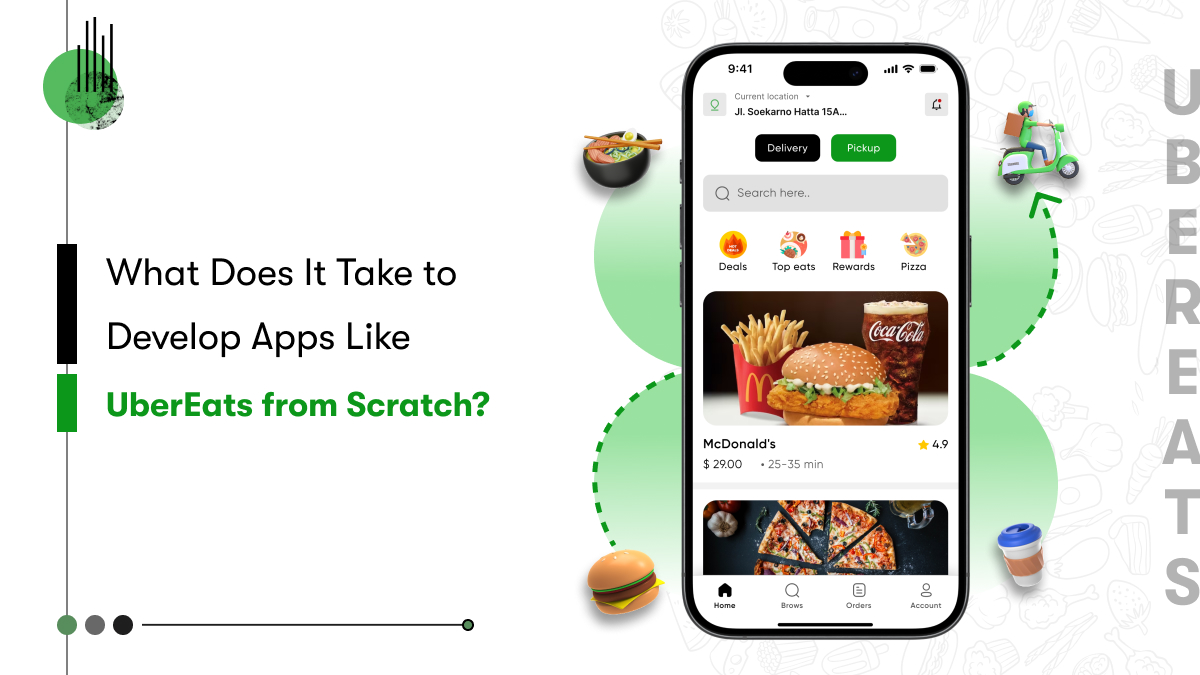
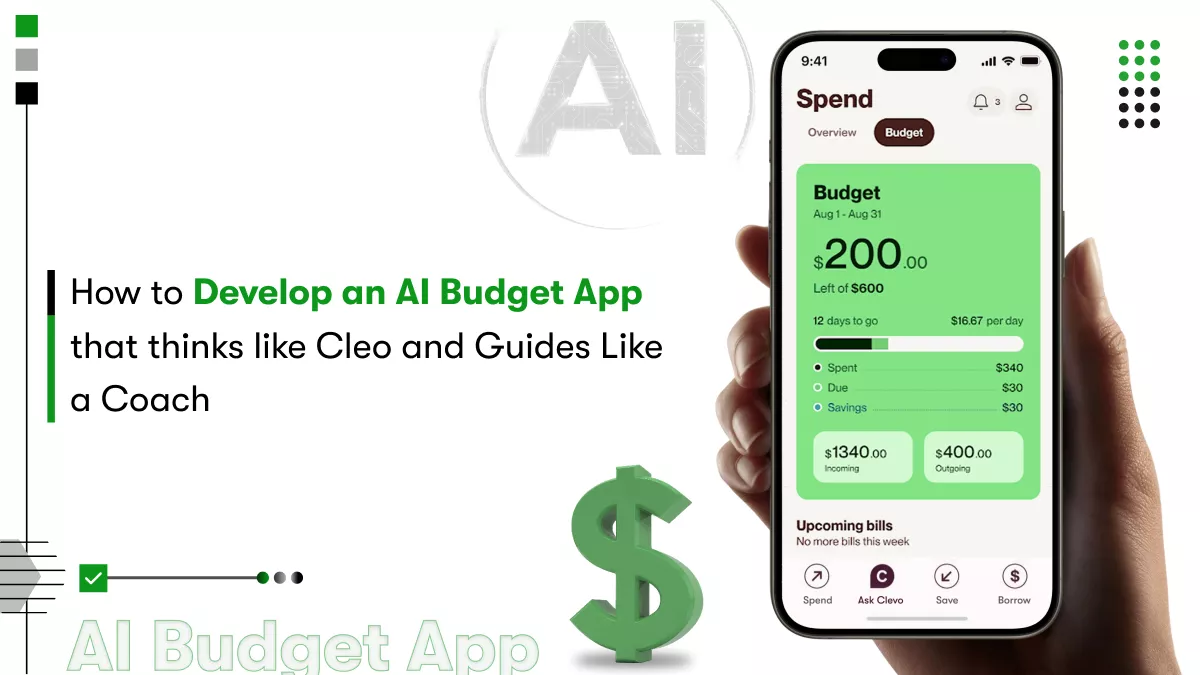
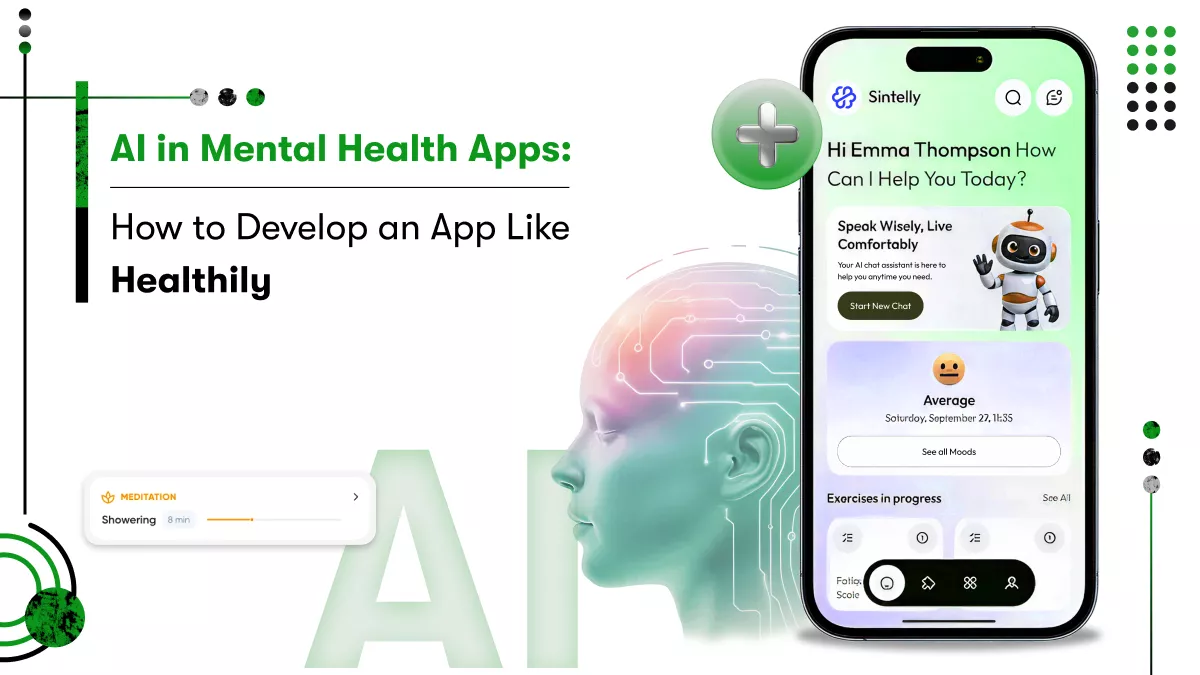
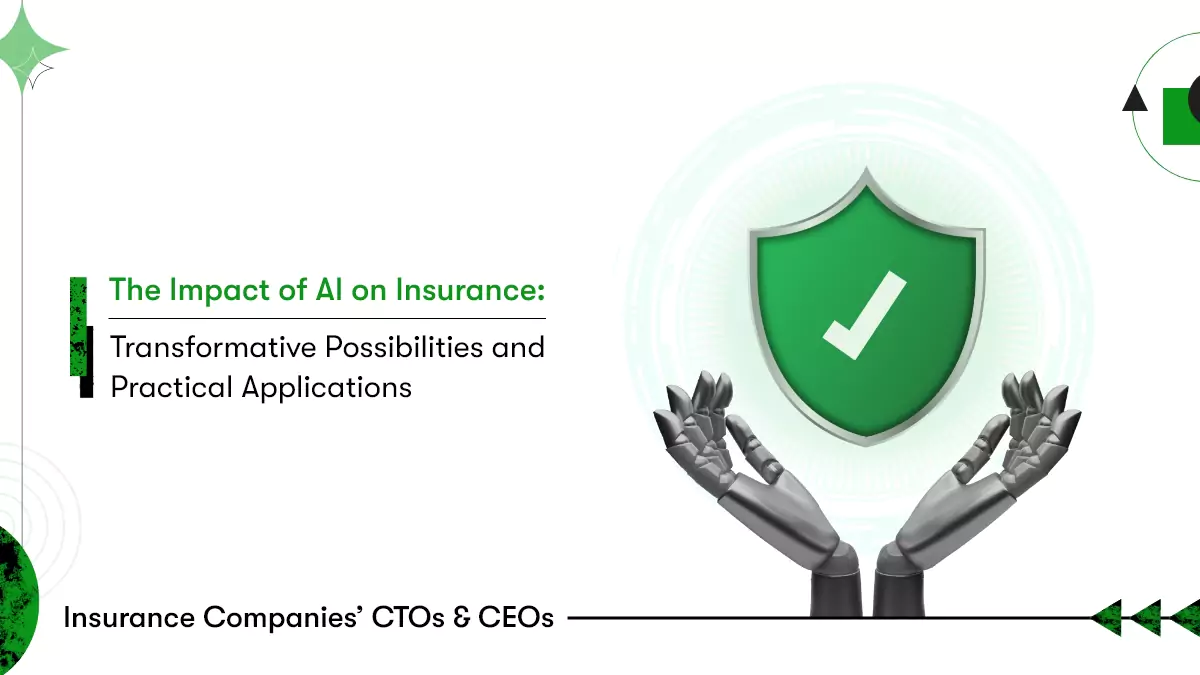
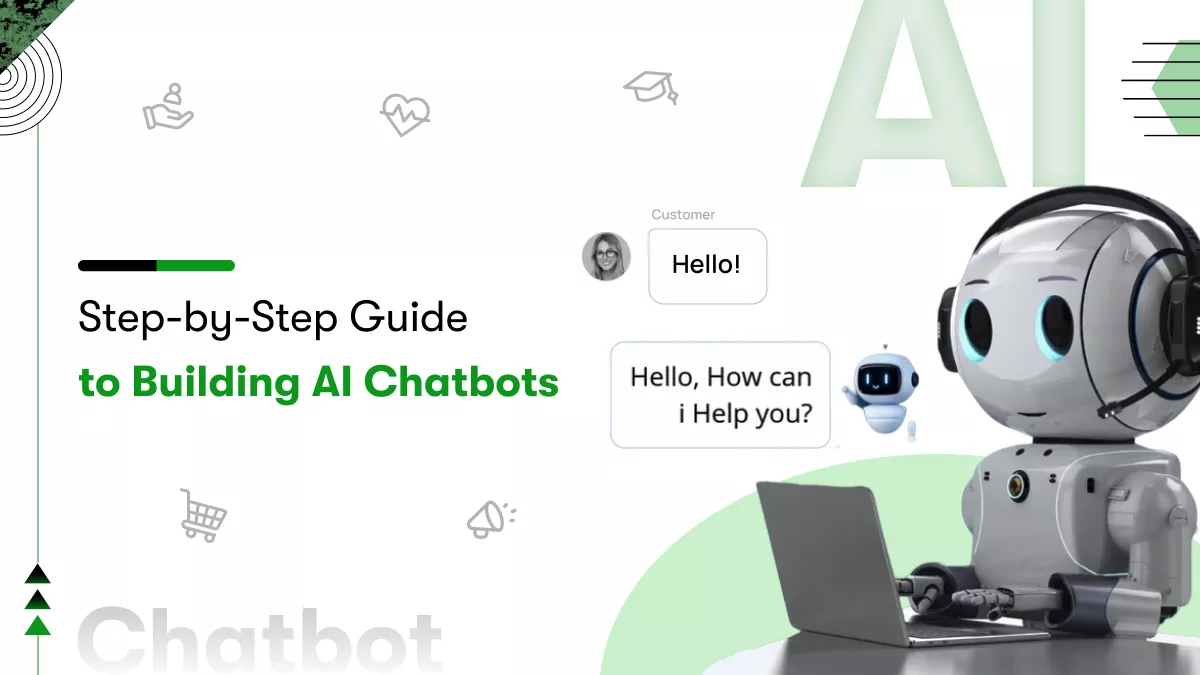
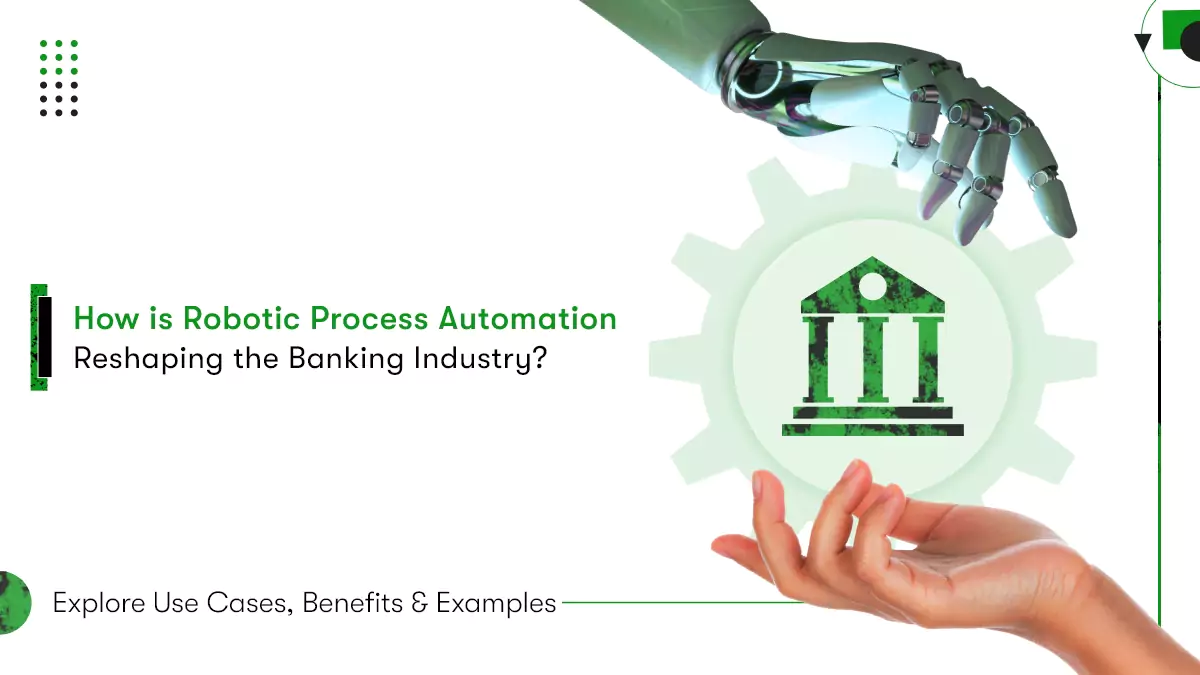

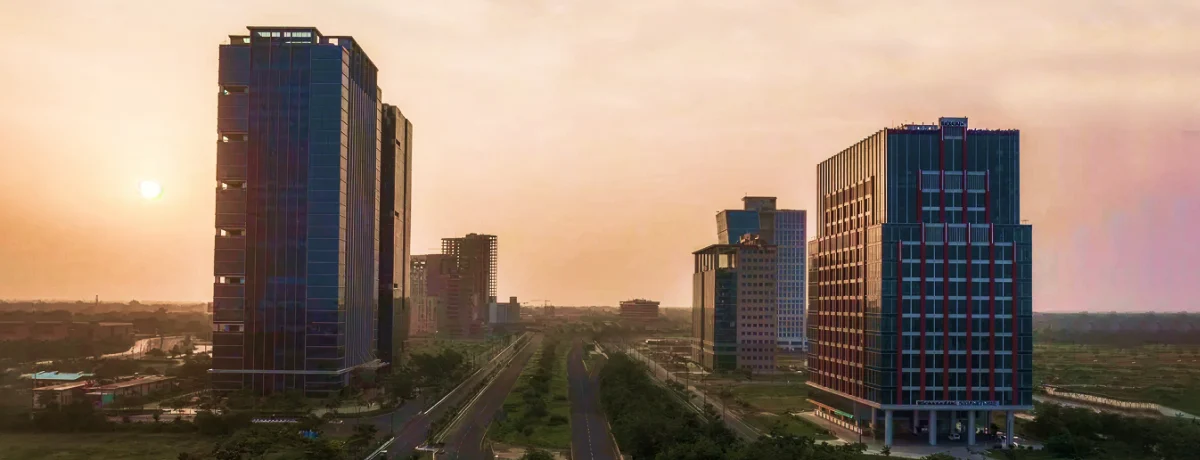




 Contact Information
Contact Information